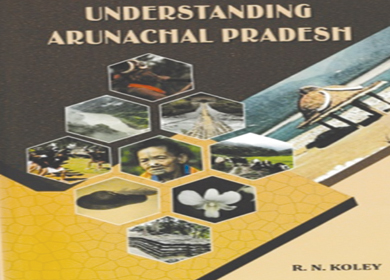A peep into the hidden land
Understanding Arunachal Pradesh
Author: RN Koley
Pages: 168
Price: 200
[ Yater Nyokir ]
The directorate of research has been publishing research papers, journals, and books on multidimensional aspects of Arunachal Pradesh since 1951. These books not only document the unwritten history of Arunachal Pradesh but also preserve the glory of the state’s rich cultural heritage. Understanding Arunachal Pradesh is an outcome of such efforts of the directorate.
The author’s account of the state, its people, and their cultural inheritance is fascinating. The title of the book says it all. RN Koley’s Understanding Arunachal Pradesh is an aggregation of weighty research findings on all the important aspects that help us understand the cultural richness of Arunachal Pradesh in proper perspective. The book is a compilation of 25 articles published and broadcast in different journals, magazines, newspapers, souvenirs, and radio talks.
The main focus of the book is on the socio-cultural practices among the different ethnic communities of Arunachal Pradesh, and also their gradual development and transition in all spheres under the influence of insidious modern culture in the last three decades. Despite not being a native of the state, the author’s profound knowledge of tribal traditions and socio-cultural life is evident in his writings. Understanding Arunachal Pradesh is the output of the sociological observation and empirical research work of the author who has been keenly observing the ethnic diversity while serving in Arunachal Pradesh. The introduction to the book is extremely illuminating and dense with details of the policies and programmes adopted by the Indian government since 1947 to administer the region.
Well-researched and wonderfully written, Understanding Arunachal Pradesh throws light on different shades of cultural ingredients, such as cultural unity, festivals, traditional village councils, indigenous games, handicrafts, cuisines, faiths and beliefs, linguistic wealth, education, folklores, folkdances, historical monuments, archaeological findings, tourism, and so on. Each section is enriching and offers the author’s authentic testimony on the features, development, and silent transition of the socio-cultural practices of the ethnic communities of Arunachal Pradesh. The author has made a deliberate attempt to bring forth the culture and the people of an unrecognized and unfamiliar landscape to the world.
The book is a documentation of the different aspects of the culture and traditions of the tribes inhabiting different places of Arunachal Pradesh, and provides relevant information articulated in lucid language, which makes the book interesting to read.
On the significance of the book – it can be an erudite guide for outsiders to grok the culture of Arunachal Pradesh through different lenses. It can be an instrument for scholars and researchers in their research activities, and also for the students who are preparing for competitive examinations in Arunachal Pradesh.
Economical with words, the author has briefly touched all the intended spheres, but it would have been more interesting to read if there had been more details and inclusion of colourful photos. Nevertheless, the book gives the distinct impression that the author is an ardent lover of Arunachal Pradesh. It is a book worthy enough to be preserved. (Yater Nyokir is a research scholar at the Arunachal Institute of Tribal Studies, RGU)



